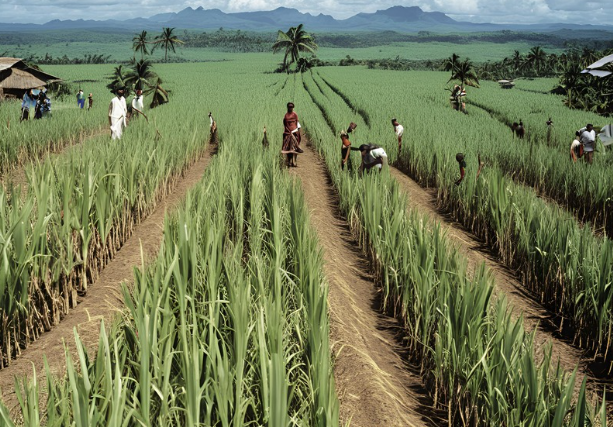Sugar History Fiji
The Fiji Sugar Industry Commencement, CSR, Development in the 1970s, Coups, Declining Sugar Production, Leases, Politics and the Indian Executives of FSC
By Pravind Kumar, Heritage Park, Brisbane, Queensland, Australia.

Wakaya Island
Commenced by David Whippy. 1866 to 1870. A sugar sample was sent to Australia. The raw sugar called in Hindi Jagrig was manufactured. Three large underground concrete tanks were built to store sugar cane juice. The sugar plantation was discontinued in 1870.
Mago (Ma'ango) Island
The Girmityas were taken to Mago Island to commence sugar cane plantations; however, due to the small area, sugar cane farming was stopped in the 1890s, and the mill parts were taken to Penang Sugar Mill. I have not been able to verify records, and investigations/research is continuing the Girmityas were shot dead and buried in the sand or taken in a small boat and ordered to jump in the sea waters. None of the Girmityas knew swimming and drowned to death or were eaten by sharks. Some were shot and thrown in the sea waters of Mago Island.
List of Sugar Mills in Fiji
- Suva Sugar Mill - 1872 to 1875
- Selia Levu Estate (Taveuni) South Taveuni near the beach. 1874 to 1890
- Penang (RakiRaki) - 1878
- Nausori Sugar Mill - 1882 to 1959
- Rarawai (Ba) Sugar Mill - 1884 to present
- Tamanua (Navua) Sugar Mill - Run by Vancouver Sugar Mill from Vancouver, Canada - 1883 to 1923
- Koronivia Sugar Mill
- Holmhurst Sugar Mill (Taveuni) - Location present on Tarte Copra and Livestock Estate - 1882 to 1896
- Viria Sugar Mill - 1896 to 1895
- Labasa Sugar Mill - 1894 to present
- Lautoka Sugar Mill - 1903 to present
- Namara Sugar Mill
The First CSR Mill
The first mill built by Colonial Sugar Refining (CSR) was the Nausori Sugar Mill on the banks of the Rewa River, which began crushing in 1882. The CSR mill at Viria, also on the banks of the Rewa River, operated from 1886 to 1895. It was closed because it was too small to be viable.
Significance of the Sugar Economy for Fiji in the Mid-1980s
The sugar economy contributed 60% to 65% of total earnings, ranging from $115 to $200 million per year. The peak was in 1987 when sugar earned Fiji $197 million. Gold contributed from 10% to 15% in the mid-1980s until 1987.
The Seaqaqa Cane Development Scheme (1975)
The Seaqaqa Cane Development was financed by the World Bank after a detailed appraisal regarding its potential for earning foreign exchange for Fiji. The sugar tonnage was as follows: 241,316 (1979), 316,036 (1982), and 224,713 (1987).
Current records are not available for the Seaqaqa area, but due to lease expiration commencing in 1997 and afterward, cane production has declined in the area.
Inconsistent Sugar Production (1980s to Present)
From 1985 to 1988, sugar production varied from 365,000 to 500,000 tons. Cyclones Eric and Nigel had a major impact on sugar production in Ba, Tavua, and Lautoka, along with the drought of 1987. The variance in sugar cane production during these years and beyond 1988 has never been researched either by academics, the Fiji Sugar Corporation, or the Sugar Cane Growers Council.
Issue of Burnt Cane (1980 to Present)
The issue of burnt sugar cane became a problem around 1980 and has continued to 2023. Statistics now reveal that burnt sugar cane supplied to the three mills is around 50%. This figure would today be the worst benchmark among sugar-producing countries, many of which ban burning cane. This should ring alarm bells for FSC and the Government of Fiji.
Recent reports indicate that the Minister of Sugar, Permanent Secretary of Sugar, CEO of the Sugar Cane Growers Council, and other executives visited Mauritius and Swaziland for a sugar conference. They also visited the President and other heads of Mauritius to discuss the sugar industry and what Fiji could learn from Mauritius. However, with Fiji's own industry in disarray, it seems there is little to learn from Mauritius regarding sugar cane yield per hectare.
Expiry of Land Leases (1997 to 2007)
From 1997 onwards, the expiry of around 20,000 leases on native land in sugar cane producing areas led to poverty and household food insecurity for many smallholder sugar cane farmers. Decreasing profits from sugar production, coupled with cultivation, harvesting, and transportation costs, along with the non-renewal of leases, all led to a loss of farmer confidence in the industry.
Declining Production and Registered Sugar Cane Farmers
Fiji's sugar cane production has declined since 1994, as has the number of registered sugar cane farmers. In 1994, there were 22,807 registered farmers; by 2018, this number had dropped to 16,666, with only 11,902 active farmers. The Minister for Sugar, CEO of the Sugar Cane Growers Council, and other officials should mandate research into how many registered farmers are absentee farmers who hold a sugar cane farming lease but do not plant any sugar cane.
Instead of flying business class and attending international conferences, these executives should focus on resolving the domestic issues facing Fiji's sugar industry.
Declining Yield per Hectare
The declining yield per hectare has been alarming for Fiji since 1988. Below are the figures:
| Year | Tonnage per Hectare |
|---|---|
| 1988 | 56 |
| 1996 | 60 |
| 1999 | 62 |
| 2012 | 36 |
| 2018 | 45 |
| 2022 | 42 |
The decline in hectares planted correlates directly with the decline in sugar production yield per hectare. Executives need to address these issues rather than focus on international travel and conferences.
Declining Number of Farmers, Young Generation, Farm Income, and Farm Size
The sugar industry in Fiji faces a significant challenge with a declining number of farmers, particularly among the younger generation, and shrinking farm income and size. These issues need urgent attention to ensure the viability of the industry in the future.
